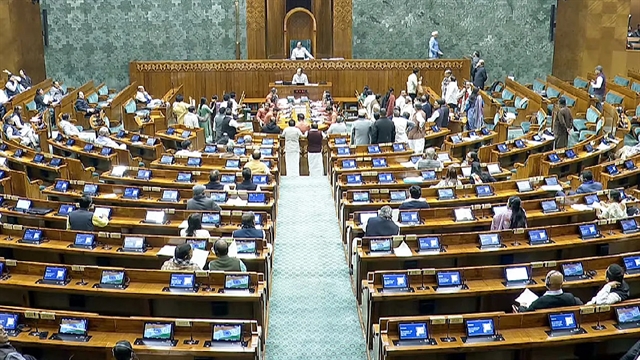 Op-Ed
Op-Ed

In what can be described as an overzealous move, authorities in the capital city have seriously drafted a Code of Conduct to “guide and correct” people’s behaviour in public places.
 |
Trọng Kiên
HÀ NỘI — In what can be described as an overzealous move, authorities in the capital city have seriously drafted a Code of Conduct to “guide and correct” people’s behaviour in public places.
Worried that citizens are falling short of standards expected of “the capital with a thousand-year civilization,” the municipal administration has expended considerable amounts of time and effort to compile a draft with 14 articles arranged in three chapters.
The draft Code of Conduct enumerates numerous dos and don’ts in both common public settings (chapter II) and specific locations (chapter III) sidewalks, bus stations, squares and parks, and entertainment venues or places of worship.
Even without the head of the municipal Culture Department admitting he doesn’t expect that the behaviour of Hanoians will ‘improve’ overnight, I cannot help feeling that this is case of a doing something for the sake of doing something.
There are several clues that point to this being an ill-conceived plan.
The drafters have not shown much faith in their work, saying that the main purpose of the document is to provide “guidance,” and that if four or five out of 10 people were mindful of the code, they would deem it a success.
But, to give credit where it’s due, the code of conduct is still in the drafting stage and the department is inviting feedback from the public.
And to see merit when there’s something to see, let’s briefly consider the “broken window theory,” developed by criminologists James Q.Wilson & George Kelling.
The basic premise of this is that small misbehaviours, if left attended, can metastasise into something far more difficult to deal with it. The metaphor’s rationale is that a broken window left abandoned in a building indicates that no one cares about it, so rule and order is not respected, leading to more broken windows.
Thus, unruly behaviour and disorderly environment allowed to fester in a community can lead to more “serious crimes and urban decay.”
The theory has been widely criticized in the US, where its adoption took the form of a rigorous policing of petty crimes, inordinately victimizing people of colour. While the racist aspect of this will not apply to Việt Nam, what should give us pause is the impacts of blowing things out of proportion and acting on it.
So, even if the basic premise of the theory carries some merit, we need to see if the prevalent feeling that things have gotten out of hand in the capital city vis-à-vis public behaviour is justified.
I feel that current concerns are driven less by actual statistics and analysis and more by a knee-jerk reaction to some controversial cases could be a few exceptions rather than the norm. I am not arguing against early intervention, but for appropriate, proportionate interventions.
Acts of vandalism, stealing items on display, jumping queues, littering, use of foul languge, urinating in public all get dramatized, and this is okay to an extent, because such behaviour cannot be condoned. Highlighting it is one thing, though, and using it to introduce intrusive measures quite another.
I agree that a “wake up call” is not a bad idea, but an official code of conduct wakes up several misgivings.
Don’ts and don’ts
While code drafters’ use of the “dos and don’ts” phrase belies its legislative nature, the document itself seems to be a mixed bag, mixing punishable offences already covered in other existing laws, like public urination and littering, with moral dictums like “should care for disadvantaged people, pregnant women, children and elderlies, standing up for right behaviours and causes, censuring wrongdoings.”
There are problems with this approach. Let me make my case.
Exhibit number one: The ban of ‘foul language and swearing’.
Full disclosure, here. I admit I am potty-mouthed myself, but only in the select company of ‘coevals,’ and this is not an attention-seeking behaviour. I would not dare to give audible expression to my ‘unprintables’ in front of those belonging to older generations, or among strangers.
I am no provocateur. I just find it fun (and effective) to express myself in diverse ways.
I argue that the use of expletives and such is not inversely proportional to one’s language skills, or even one’s education level. And no, this is not a passing phase or a fad, it’s personal freedom of expression, used in creative ways, if I may say so.
If someone were to overhear my colourful conversation, as a public citizen, is he bound to report me to the authorities?
Will a special task force be appointed to eavesdrop on conversations in public spaces?
Exhibit number two: People should ‘dress appropriately, suitable to the occasion.’
Such rules in specific settings are fine. No shorts or skimpy clothing allowed in pagodas and other places of worship, for instance. Uniforms in schools, fine. Beyond this, isn’t this a question of common sense and personal taste? Can we criminalize bad taste?
Once again, the pesky questions of enforceability and the effectiveness of enforcement raise their irritating heads.
Even a no-brainer unacceptable behavior like public urination does not happen in vacuum. If there are enough clean public restrooms, would this behaviour arise? Who’s to be penalized then? The “urinator” or the one responsible for the lack of public toilets?
This leads us to overly effusive displays of affection. How do we regulate this? No kissing on the lips for more than two seconds? No hugging, no holding hands, no standing too close to each other? When does a dress get too skimpy and go “against tradition?”
I am yet to rest my case, because the ramifications of this code of conduct go beyond its content, to the implications of authorities acting as some kind of moral police.
As they say, the road to hell is paved with good intentions, and some parts of this code can end up opening a Pandora’s box of cultural mayhem.
Instead of re-thinking provisions of the Code of Conduct, we should re-think its viability, its meaning and necessity as a legally enforceable document. —VNS



.jpg)
